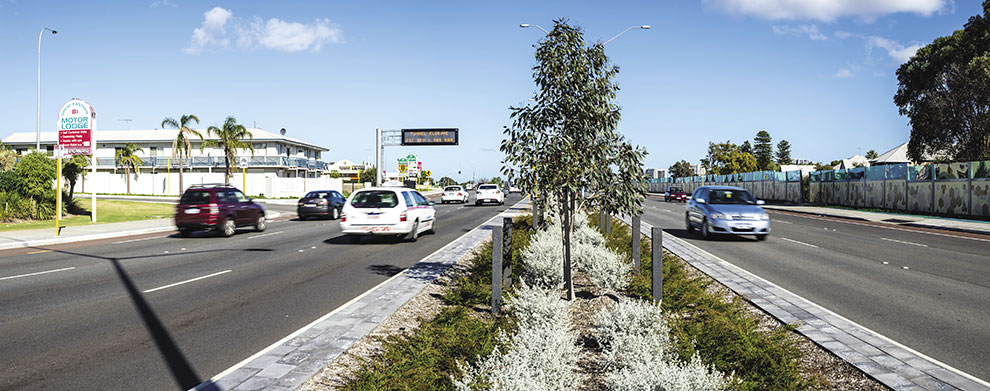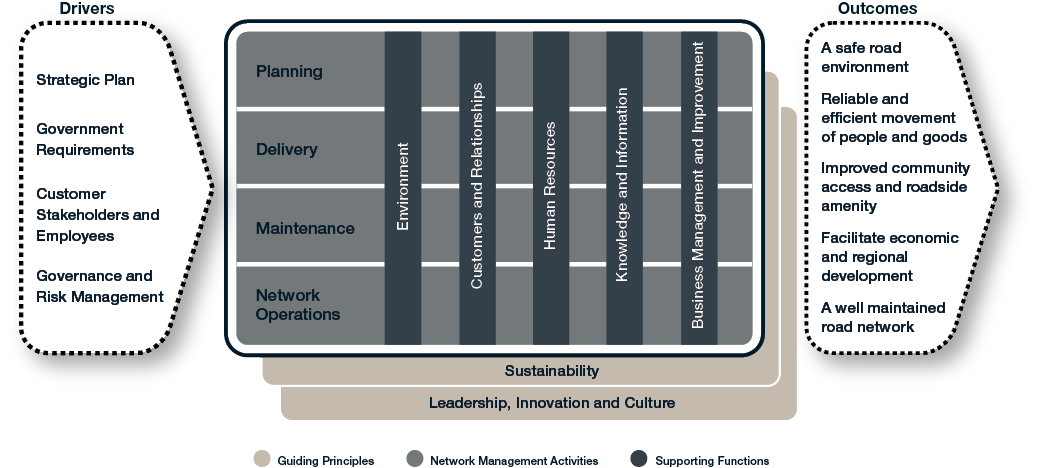
Principle 4: Operations
Corporate Business Plan 2013-2017
We produce a Corporate Business Plan which is aligned to our strategic direction and Government goals and objectives. It forms the basis for all Directorate and Branch Business Plans and will ensure that planning, delivery, maintenance and operational activities are aligned with corporate direction and priorities. This approach is built on meeting our strategic and future needs and achieving a greater integration of strategic, workforce, operational and financial planning needs.
The Business Planning process defines how we go about our business and identifies our annual corporate initiatives and actions within a context of a four year timeframe. The Business Planning model below shows the relationship between internal business management processes and how they interact with our drivers to achieve our Program Outcomes and Government Goals.

The following table explains each of the elements within the business planning model.
Drivers |
The drivers represent influences that must be taken into consideration as part of everything that we do. Although there were many drivers we have only identified those which are of greatest significance. |
Guiding Principles |
Sustainability, Leadership, Innovation and Culture are broad guiding principles that form the backbone of all of our activities. Everyone is expected to consider and apply these principles in understanding any initiatives or actions we engage in. |
Activities and Functions |
The main element within the model comprises a matrix consisting of Network Management Activities. These activities are considered to be our core functional activities. They are underpinned by a range of supporting functions that exist only to achieve the network management activities. |
Outcomes |
Program Management is the manner in which our services are delivered to the community. There are seven Programs aligned against the five outcomes sought from each of our services. |
Progress against achievements in the Corporate Business Plan are monitored, reviewed and evaluated which is an important element in the entire process. We have in place a range of initiatives to review our progress in achieving our stated aims. The following table provides an overview of the formal processes that are in place.
Monthly |
|
Quarterly |
|
Bi-annually |
|
Annually |
|
Financial Targets: Actuals Compared to Budget
The following table provides a comparison of the financial targets and outcomes against criteria included in the Resource Agreement between the Commissioner of Main Roads, Minister for Transport and the Treasurer.
2012-13 Target(1) $000 |
2012-13 Actual $000 |
Variation(2) |
|
Total Cost of Services |
1,888,459 |
1,872,724 |
15,735 |
Net Cost of Services |
1,170,241 |
1,261,586 |
(91,345) |
Total Equity |
42,643,364 |
41,139,566 |
1,503,798 |
Net increase/(decrease) in cash held |
(143,790) |
(167,120) |
(23,330) |
- As specified in the latest budgets statements relating to estimates for 2012-13.
- Explanations of variations:
- The variations in relation to Total Cost of Services can be mainly attributed to State funds advanced for the Gateway WA Project.
- The variation in Net Cost of Services relates to reduced Commonwealth grants received under the Nation Building program due to delays in the approval of the Project Proposal Report for Gateway WA, as well as some major capital projects completed ahead of schedule.
- The variation in relation to Total Equity relates mainly to decreases in the value of Land Under Road Reserves required under Accounting Standards to prevailing market based written down replacement costs.
- The decrease in cash being lower than budgeted can be attributed to reduced Commonwealth grants received under the Nation Building program due to delays in the approval of the Project Proposal Report for the Gateway WA Project, as well as some major capital projects completed ahead of schedule.
Further explanations are also contained at Note 41 of the Financial Statements.
Integrated Management System
We have adopted a systematic approach to improving business performance based on quality management principles. The Integrated Management System brings together all of our third-party certified processes into a single structure. During the year we undertook a full audit of our entire Management System achieving re-certification through to 2016. Continuous improvement is the cornerstone of all our management processes and procedures.
We are keeping a close watch on the development of new International Standards for Road Safety and Asset Management. We have people involved in the development and review of the direction of each new standard with a view to adopting them under our Integrated Management System at the earliest opportunity.
Current Certification |
|
Standard |
Processes |
Quality Management System AS/NZS ISO 9001:2008 |
Project Management, Contract Management, Supply, Corporate |
Environmental Management System AS/NZS ISO 14001:2004 |
Environmental |
Occupational Health and Safety Management System AS/NZS 4801:2001 |
Occupational Health and Safety |
Completion of Better Business Project
The Better Business review project was introduced in 2009 to increase the efficiency of our business. The intent of the review was to identify where improvements and efficiencies could be made regarding the way we run our business, whilst shifting our culture to embrace change and innovation.
As part of working to complete the 106 recommendations, strong leadership, collaborative relationships and innovation have become embedded in our culture thereby sustaining the efficiency and the effectiveness of our business.
As the project comes to a close, key results include increased productivity through improved processes, employee engagement, and retention of key skills and tacit knowledge. Decision making was enhanced through greater transparency in the organisation and delivery of timely and accurate information. Initiatives focused on current capabilities and future human capital requirements, improving internal customer service whilst also ensuring that we meet community needs and expectations.


